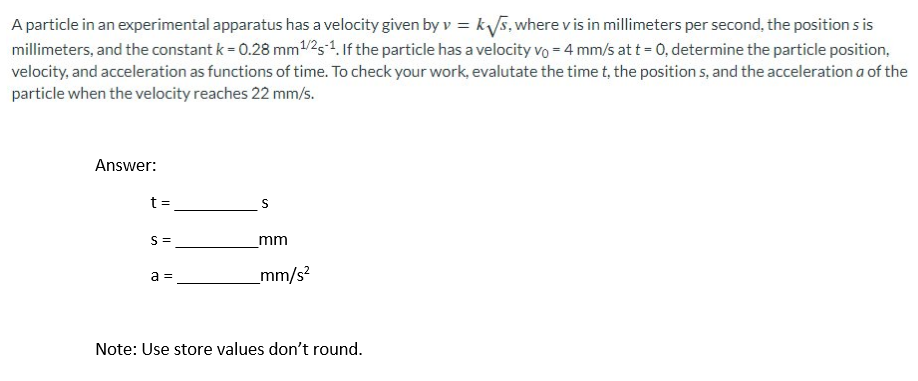A particle in an experimental apparatus has a velocity given by v = k√s, where v is in millimeters per second, the positions is millimeters, and the constant k = 0.28 mm ¹1/25-1. If the particle has a velocity vo = 4 mm/s at t = 0, determine the particle position, velocity, and acceleration as functions of time. To check your work, evalutate the time t, the positions, and the acceleration a of t particle when the velocity reaches 22 mm/s. Answer: t = S= a = S mm _mm/s² Note: Use store values don't round.
A particle in an experimental apparatus has a velocity given by v = k√s, where v is in millimeters per second, the positions is millimeters, and the constant k = 0.28 mm ¹1/25-1. If the particle has a velocity vo = 4 mm/s at t = 0, determine the particle position, velocity, and acceleration as functions of time. To check your work, evalutate the time t, the positions, and the acceleration a of t particle when the velocity reaches 22 mm/s. Answer: t = S= a = S mm _mm/s² Note: Use store values don't round.
Classical Dynamics of Particles and Systems
5th Edition
ISBN:9780534408961
Author:Stephen T. Thornton, Jerry B. Marion
Publisher:Stephen T. Thornton, Jerry B. Marion
Chapter3: Oscillations
Section: Chapter Questions
Problem 3.22P: Let the initial position and speed of an overdamped, nondriven oscillator be x0 and v0,...
Related questions
Question
need fast pls

Transcribed Image Text:A particle in an experimental apparatus has a velocity given by v = k√√s, where v is in millimeters per second, the position s is
millimeters, and the constant k = 0.28 mm ¹/25-1. If the particle has a velocity vo = 4 mm/s at t = 0, determine the particle position,
velocity, and acceleration as functions of time. To check your work, evalutate the time t, the positions, and the acceleration a of the
particle when the velocity reaches 22 mm/s.
Answer:
t =
S=
a =
S
mm
_mm/s²
Note: Use store values don't round.
Expert Solution
This question has been solved!
Explore an expertly crafted, step-by-step solution for a thorough understanding of key concepts.
Step by step
Solved in 4 steps with 3 images

Knowledge Booster
Learn more about
Need a deep-dive on the concept behind this application? Look no further. Learn more about this topic, physics and related others by exploring similar questions and additional content below.Recommended textbooks for you

Classical Dynamics of Particles and Systems
Physics
ISBN:
9780534408961
Author:
Stephen T. Thornton, Jerry B. Marion
Publisher:
Cengage Learning

University Physics Volume 1
Physics
ISBN:
9781938168277
Author:
William Moebs, Samuel J. Ling, Jeff Sanny
Publisher:
OpenStax - Rice University

Classical Dynamics of Particles and Systems
Physics
ISBN:
9780534408961
Author:
Stephen T. Thornton, Jerry B. Marion
Publisher:
Cengage Learning

University Physics Volume 1
Physics
ISBN:
9781938168277
Author:
William Moebs, Samuel J. Ling, Jeff Sanny
Publisher:
OpenStax - Rice University